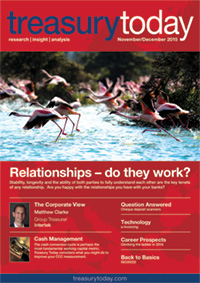Contents
- Editorial
- Predicting the future… or is it too late?
- Question Answered
- Question Answered: Best practice: cheque deposit
- Market View
- Europe strains under the pressure of migrant crisis
- Insight & Analysis
- How to get more from your banks
- The Bigger Picture
- The rise and fall of Mr Copper
- Special Feature: Thomson Reuters
- Africa: perception vs perspective
- The Corporate View
- Corporate View: Matthew Clarke, Intertek
- Country Profile: HSBC
- Germany: Europe’s powerhouse
- Technology
- A long time coming
- Special Feature: ING
- Sustainable treasury
- Career Prospects
- Mind the gap
- Cash Management
- Cycle repairs
- Back to Basics
- Raising the standard
Editorial
Predicting the future… or is it too late?
October 21st 2015 has just passed. Those of you who are familiar with the American science-fiction adventure movie ‘Back to the Future’ will appreciate the significance of this date. For those of you who aren’t, it is interesting to observe that some of the predictions in the film have actually come true. Personal drones, tablets and mobile payment technology, biometric devices, hands-free gaming consoles, smart clothing and wearable technology, video phones, waste-fuelled cars, hover-boards and video glasses are all a reality. Wal-Mart Stores is even applying to US regulators for permission to test drones for home delivery, curb-side pickup and checking warehouse inventories, as it goes head-to-head with Amazon in using these aerial devices to fulfil online orders.
There is clearly validity in those predictions dating back 30 years and, although perhaps not as impressive, we can try to predict what might happen in the world of treasury and finance in 2016 and beyond.
In recent months we have witnessed the likes of foreign exchange and LIBOR rigging scandals at the banks, a potentially catastrophic exposé at Volkswagen and various cyberattacks on numerous websites. All of these examples have a potential impact on the corporate treasury function. But what, if anything, could a corporate treasurer have put in place to mitigate the risk of the immense damage to corporate reputation that such events inevitably cause? This is something we will look at in 2016.
Stay safe
Cyber security is set to remain a huge topic in 2016, affecting not just reputational risk but the increased threat to data security. This is an area where treasurers have always been careful, even slowing the adoption of mobile solutions in the corporate banking space. Which way will this go in 2016? We’ll keep our eyes open and ears to the ground, reporting on what we find.
The rise of words such as cryptocurrency, cyber-crime, digitisation, bitcoin, blockchain and FinTech has required the corporate treasury function to learn a whole new language and vocabulary. Block chain technology, in particular, which is also being referred to as ‘distributed ledger’, is a very hot topic with bankers. But they still seem to be at the ‘kicking the tyres’ stage with no-one yet taking the plunge. Most corporates can sit back and wait – if you already accept Bitcoin, you are several steps ahead of the rest of us. We hope you’ll tell us your story.
What is abundantly clear, however, is the renewed focus on risk and the many forms in which it manifests itself: currency and commodity price volatility; cyber-attacks; political instability; fraud; counterparties; and your supply chain – all face very real threats that must be managed.
Equality in the Boardroom? Not quite
It was reported this week that the FTSE 100 firms in the UK have met a voluntary target of 25% of women board members. Lord Davies, former Trade Minister, has now said this should be replaced by a new target of 33% of women board members at FTSE 350 firms by 2020. The issue of quotas has been fiercely debated through the Treasury Today Women in Treasury initiative. The issue was tabled for a Women in Treasury webinar on 23rd November in which we reported the results of the 2015 Global Study. If you would like to hear what was said please see treasurytoday.com/webinars.
Reader Survey
Thank you to all our readers who participated in our Reader Survey which recently closed. We have taken on board all you have said and will ensure we address the points you have raised as we build our plans for 2016.


